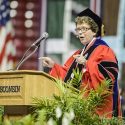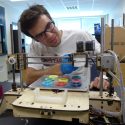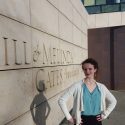Chancellor Blank honors students for outstanding research, service
University of Wisconsin–Madison undergraduate students are using their skills and passion to conduct impressive research in fields as diverse as the inside of the human mind to a galaxy far, far away.
More than 150 students were honored for their work at the annual Chancellor’s Undergraduate Awards Ceremony on Tuesday, May 3. Many of these awards provide students with funds to conduct research projects independently or in collaboration with faculty. Others recognize students’ impressive academic or community service achievement. Fourteen recipients and finalists of nationally competitive scholarships will also be acknowledged.
Research topics range from stem cells to motion sickness to the social status of wintering birds. Leah Fulmer, a junior majoring in astronomy-physics, physics, and Spanish, is pursuing a project that will take her to the skies.
Fulmer won a Hilldale Undergraduate Research Fellowship that will enable her to help broaden the current understanding of how stars are formed. The dominant star-formation theory states that stars need dense molecular gas to form, and consequently typically form in high-density gas regions. This idea doesn’t explain the massive stars that form in low-density gas regions or how the first stars were formed before complex molecules existed.
To investigate this, Fulmer is looking at one low-density gas region, a star cluster known as NGC 602. Fulmer will be extracting data to determine the ages of all 1,000 stars in the cluster.
Her research is not only impressive in its span, but in its importance to the field of astronomy.
“This anomaly of this massive star formation is really challenging what the whole community understands about star formation right now,” she said.
Ryan Raut, a senior majoring in neurobiology and psychology, also engages in innovative research, but his subject area is considerably closer to home. Raut won a University Book Store Academic Excellence award for his work exploring the human brain.
Raut’s interest in neurobiology began when as a freshman psychology major, he decided, almost flippantly, to take an optional neuroscience seminar.
“It ended up changing my life,” Raut said.
The seminar introduced him to the dominant tool of cognitive neuroscience and his future research partner: functional Magnetic Resource Imaging (fMRI).
A fMRI is used to measure brain activity by detecting the high oxygenation that comes with blood flow. Raut’s project helps determine whether fMRIs can effectively detect brain activity in stroke victims, whose cerebral vasculature may be damaged, disrupting blood flow. Because fMRIs are used to predict recovery outcomes for stroke patients, it is important to understand how accurately they can diagnose which parts of the brain are active.
Next year, Raut will start a PhD program in neuroscience, where he’ll continue working with fMRIs.
“I want to go to the cutting edge of what fMRI is being used for,” he said.
Fulmer has similarly big dreams. A thousand stars are not enough to satisfy her appetite for research.
“I’m really still looking to broaden my research experiences,” said Fulmer. “I love studying galaxies, I hope to love studying star formation, but I think I want to do something more along lines of dark matter, or black holes, dwarf galaxies or something I really haven’t touched yet.”
Other awards include the Holstrom Environmental Scholarship, the Sophomore Research Fellowship, the Theodore Herfurth and Teddy Kubly Award for Initiative and Efficiency.
A full list of award recipients can be found here.
In addition, 29 students have been selected to receive the Meyerhoff Awards, which recognize a commitment to community service. That ceremony will take place Friday, May 6.
Subscribe to Wisconsin Ideas
Want more stories of the Wisconsin Idea in action? Sign-up for our monthly e-newsletter highlighting how Badgers are taking their education and research beyond the boundaries of the classroom to improve lives.



